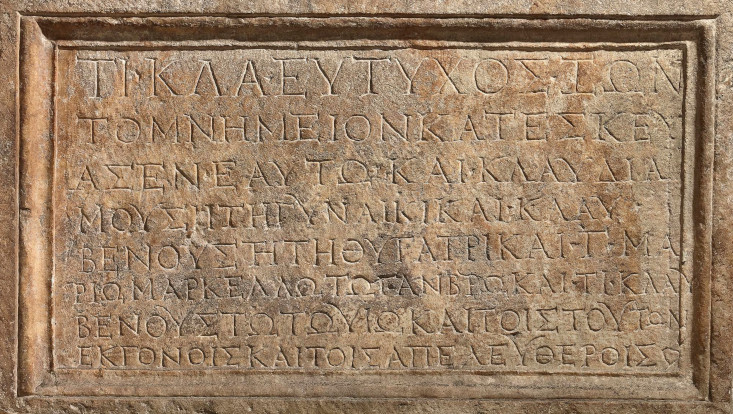Provisions, Prohibitions and Sanctions. Tomb Protection in Greco-Roman Antiquity as Reflected in the Epigraphic Sources
1st Edition of the 'Hamburg Conference on Ancient Legal History'
One of the most striking features characterizing the epigraphic culture of the Greek East is the plentitude of funerary inscriptions. Their spectrum ranges from brief epitaphs only revealing the name of the deceased to texts displaying comprehensive provisions geared towards the future, with their memorial content clearly receding behind efforts of regulating the use of the monument. This latter type is prominently attested in Asia Minor, with several thousand examples dating to the Hellenistic and Imperial periods; numerous examples are furthermore known from Macedonia, the lower Danube regions, as well as Rome and the Italic peninsula.

On the one hand, the regulations given in these texts show considerable similarities, e.g. when seeking to keep unauthorized persons from using the tomb. On the other hand, local particularities can be observed regarding the chosen formulae, the selection of the specific prohibitions, the details of the sanctions imposed and the recipients of the fines. Recent scholarship has seen a rising interest in this particular set of evidence. It is, thus, the intention of the conference to equally map the traditions and the diversity of this peculiar epigraphic phenomenon as well as to further our understanding of the underlying legal and social frameworks.
Hosts:
Prof. Dr. Kaja Harter-Uibopuu, Department of History, University of Hamburg
Dr. Karin Wiedergut, Department of History, University of Hamburg
| Date: | October 12-14, 2022 | |
| Location: | University of Hamburg | |
| Contact: | Karin Wiedergut | |
Call for Papers
The following selection of topics is intended to provide suggestions for contributions:
Acquisition of the tomb: Burial facilities could either be built from scratch or made ready by using an existing structure. In both cases, legal authorization had to be at hand, which could be acquired against payment or free of charge by the tomb founder. Though a specific mentioning in the epitaph was not obligatory, many texts nevertheless deliver accounts of the transfer of ownership or the acquisition of usage rights. The pertaining details, with a focus on local patterns, are of equal interest here as are the different approaches within Greek and Roman law.
Entitlement for burial and possibilities of transfer: The “burial community” of a tomb monument is usually constituted by its owner’s nuclear family, viz. his wife/her husband and their children. This limited circle is often extended by (at least) one additional generation, addressed in a very general manner (... καὶ ἐγγόνοις). Apart from these seemingly rather practical necessities, what were other possibilities to grant the right of burial? And, conversely, what were the ways and methods to prevent the burial of even close relatives?
Prohibitions: As it is with numerous other regulations, the given set of regulations is complemented by prohibitions and protected by sanctions. As one would expect, prohibitions seeking to prevent the burial of unauthorized persons are numerically predominant to all other categories. Although these clauses are aimed at the general public in terms of their formulation, the texts nevertheless allow for further considerations, e.g. on the question if the tomb owner did, in actual fact, have in mind a more specific group of persons. Additionally, a closer look on other categories of prohibitions is called for, such as the ban on opening or selling the tomb, of altering the inscription, or of destroying the monument as a whole. Are local patterns emerging? What combinations can be found? And: To what extent can these prohibitions be considered effective, from a legal as well as a practical perspective?
Sanctions: Fine or curse? Tomb owners of the Roman Imperial period usually opted for the first variant, and set a specific amount of money to be paid to a public institution, in the hopes that the fine would be painfully enough to discourage potential violators. Of interest here are, e.g., the frequency of certain public or sacred bodies as recipients of these fines as well as the conspicuous absence of other, locally prominent institutions, the specific amounts of the fines as well as the occasional deviation from common patterns, such as the demand for payments in gold or to one's own family.
Prosecution and enforcement: Appealing to a volunteer (ὁ βουλόμενος) was the most common way to involve the general public in the protection of one's burial place and corresponded to the regulations observable also in other areas of polis law. By promising a monetary reward, it was possible to ensure that individuals outside one's own family were interested in monitoring the compliance with the provisions recorded in the inscription and, should it be required, would even be able to take action against the tomb owner’s family. The dissemination and formulation of these and similar provisions are of interest here, as are considerations of the specific procedure, the legal ground to the clauses as well as the integration of their implementation into the legal system of the Imperial polis.
We are looking forward to your contributions on these or similar topics in German or English and ask for submission of an abstract by February 20, 2022.
The conference will be held at the University of Hamburg, the subsequent publication of a conference volume is intended.
Prof. Dr. Kaja Harter-Uibopuu, kaja.harter@uni-hamburg.de
Dr. Karin Wiedergut, karin.wiedergut@oeaw.ac.at
